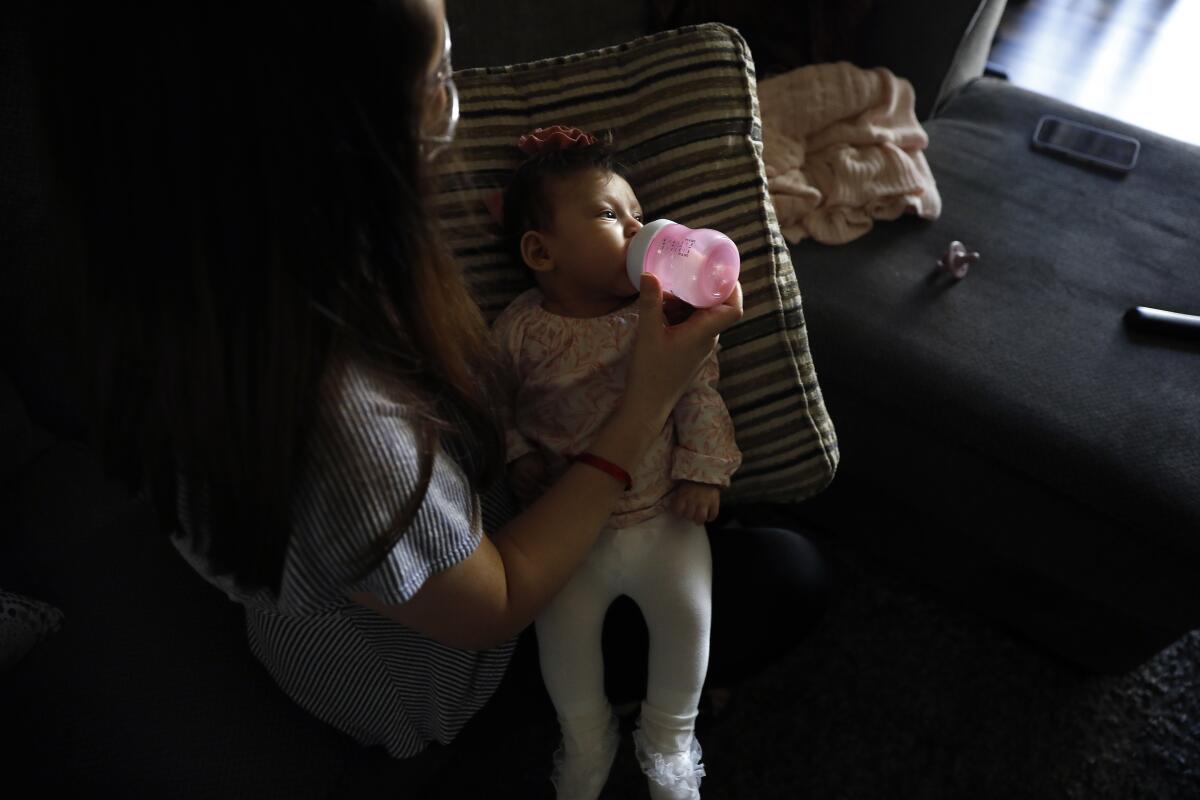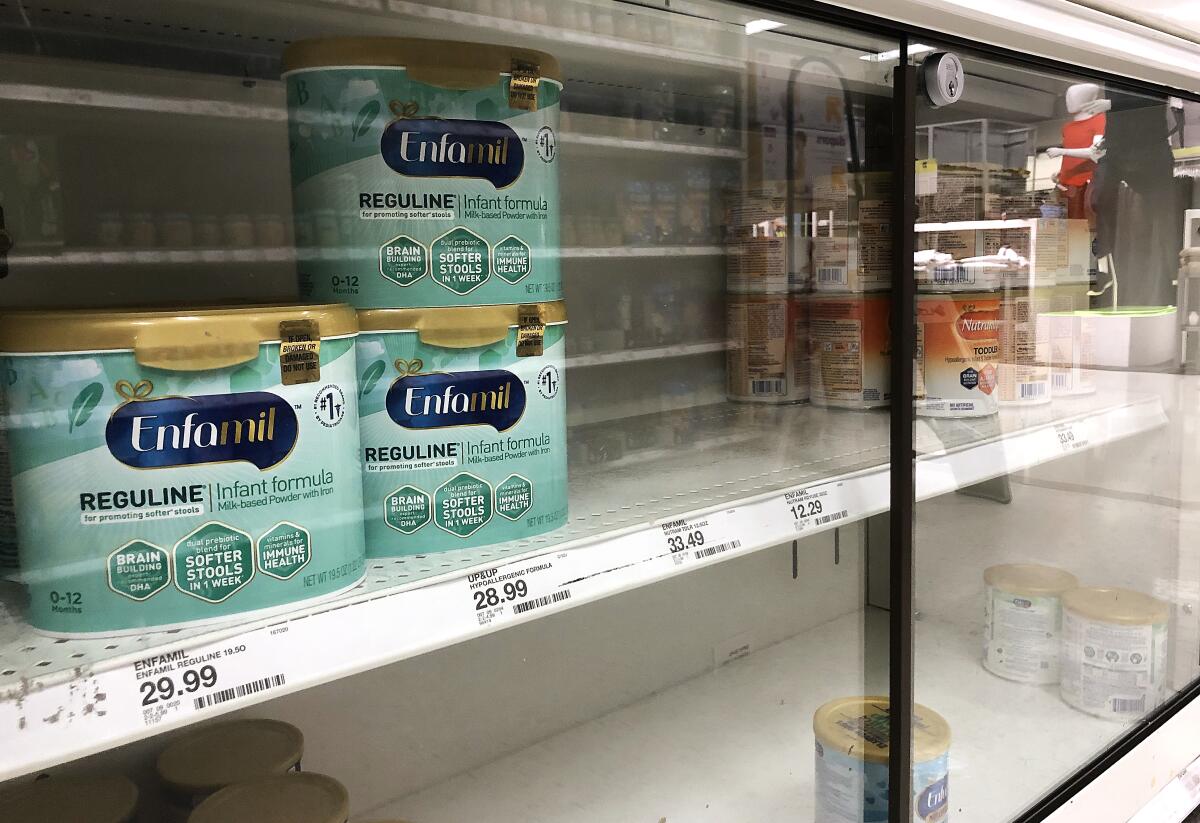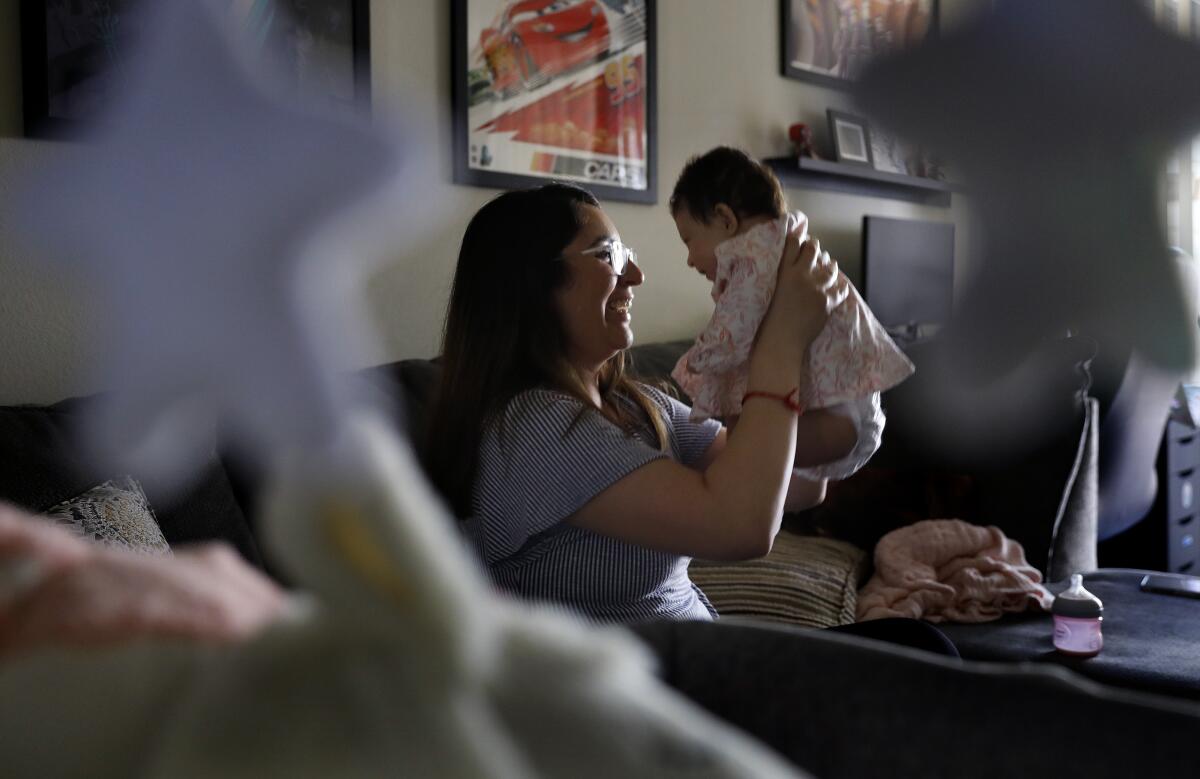A medida que se agrava la escasez de leche de fórmula para bebés, las familias toman medidas desesperadas

- Share via
Como la mayoría de las madres primerizas, Verónica Gutiérrez, de 26 años, ve que su vida gira en torno a la alimentación de su hija de 3 meses, Alessandra.
Durante el primer mes, eso significó principalmente leche de fórmula. Pero la fórmula era difícil de encontrar. Iba de tienda en tienda, y se impresionó tanto por las estanterías vacías, que empezó a extraerse leche materna a todas horas, con la esperanza de poder sacar lo suficiente para alimentar a Alessandra.
“Cuando buscaba leche de fórmula y no la encontraba, casi se me saltaban las lágrimas”, cuenta Gutiérrez.
“No sabía si iba a encontrar la fórmula”, dijo. “Por eso todos los días le daba pecho, aunque le diera sólo un poco, porque sabía que, si no lo hacía, perdería la producción de leche”.
Durante la noche, Alessandra toma el pecho. Durante el día, Gutiérrez se extrae leche. Aun así, se considera afortunada. A diferencia de millones de familias estadounidenses, ya no le preocupa de dónde vendrá la próxima comida de su bebé.
La transición de un bebé alimentado con fórmula a la leche materna, es una tarea hercúlea. Pero no es con mucho la medida más extrema que han tomado las madres desesperadas ante la creciente escasez de leche artificial.
“Las familias tienen que rebajar la leche artificial o utilizar leche [de vaca] cuando no tienen otra opción”, explica Kelly Sawyer Patricof, de Baby2Baby, una organización sin ánimo de lucro con sede en Los Ángeles que distribuye leche artificial y otros suministros a las familias necesitadas. “También utilizan el zumo como sustituto o la transición a los alimentos sólidos antes de que sus bebés estén preparados desde el punto de vista del desarrollo”.
La crisis se ha agravado durante meses, mientras millones de padres luchan por alimentar a sus hijos. Pero las madres de bajos ingresos, como Gutiérrez, se han visto especialmente afectadas. Alrededor de la mitad de la fórmula infantil que se vende en Estados Unidos se adquiere a través del Programa Especial de Nutrición Suplementaria para Mujeres, Bebés y Niños, o WIC, que paga los alimentos para las personas embarazadas y los niños menores de 5 años que viven en pobreza.
Aunque todo tipo de bebés reciben leche de fórmula por todo tipo de razones, los beneficiarios del WIC, como Alessandra, la reciben aproximadamente al doble del precio sus vecinos más ricos. En el sur de Los Ángeles, más del 70% de los bebés de la edad de Alessandra se alimentan con leche artificial; en el Westside, aproximadamente la misma proporción recibe sólo leche materna. En toda California, unos 150.000 bebés reciben leche artificial a través del programa.
Ahora, muchas madres dicen que les cuesta mucho trabajo encontrarla.
“Hoy fui a nueve tiendas y apenas conseguí algo de fórmula”, dijo Jocelyn Landers, una enfermera en Harbor City que compra fórmula bajo el programa WIC para su hija de 2 meses, Alaya. “Me sentí agradecida de conseguir siquiera una lata. No entiendo cómo hemos llegado a este punto”.
Escasos suministros la semana pasada en una tienda de Compton.

The shortage began late last year, months before Alaya or Alessandra were born. At the time, many formula ingredients were caught in the disrupted supply chain, alongside infant strollers, car seats and cribs.
But the shortage grew more dire in February, after two babies died and two others were hospitalized with Cronobacter infections linked to formula from an Abbott Laboratories plant in Sturgis, Mich.
Abbott makes more than 40% of the baby formula sold in the United States, mostly under the brand Similac. It is also the primary supplier for WIC programs in many states, including Louisiana, Washington and Texas.
The infections touched off a wave of recalls, mostly of specialty formulas used by medically fragile babies and children. Worse, the plant — the largest manufacturing facility for the largest formula supplier in the country — was shuttered.
“With the combination of all these production issues and the recall, there’s a significant shortage on all ends,” said Nicole Meadow, a clinical dietitian in the Heart Institute at Children’s Hospital Los Angeles. “Several times a day I’m sending cases of formula to a family, just to help with the gaps.”
California’s WIC program is contracted with Mead Johnson, the maker of Enfamil, which controls most of the rest of the market. But there, too, supply chain issues persist.
Earlier this week, the glassed-in shelves of formula at a Target store in Compton were picked almost bare. Online, the retailer was no longer listing the products covered by WIC, nor almost any other formula.
As Similac has dried up, parents with means have sought out alternatives. Millions choose formula because they can’t nurse or don’t want to, because their infants are adopted or born through surrogacy or because they’ve struggled to produce enough milk. Some are now buying formula from abroad, while others have switched to pricier boutique brands.
Parents of children with allergies or complex medical needs have enlisted doctors, pharmacists and extended family networks to source the specialized formula they need.
“It was like, all of a sudden, we couldn’t find anything,” said Agoura mom Gillian Mahar, whose 9-month-old twins need hypoallergenic formula. “My husband and I probably went to 50 stores within a 20-mile radius. We had family members who were driving from Phoenix to L.A., stopping in every Target and grocery store on the way, trying to find it.”
Many others have simply switched to Enfamil. Increasingly, they reach for the 12.4-ounce cans, the only size paid for by WIC.
“I’ve gone to stores in Long Beach, I’ve gone to Rolling Hills, Carson — I’ve gone to Inglewood just to see if I could get lucky,” said Landers. “If they do have it, it’s the larger size; it’s not the size that’s approved.”
That means the low-income mom is either out of luck or has to pay for the pricey formula herself. She cannot afford it.
On Thursday, President Biden urged states to loosen restrictions on the brand, type and size of formula that families can buy through the program. But even with those constraints lifted, WIC mothers have fewer options than many other parents, because eligible families are disproportionately likely to use formula in the first place and to live in neighborhoods with others competing for the same six types of Enfamil powder.
“Return to work is a big barrier for continued breastfeeding when you’re lower income,” said Dr. Shannon Whaley, director of research and evaluation at PHFE WIC, which serves Southern California.
That’s because many WIC-eligible mothers don’t qualify for California’s paid family leave program or can’t afford to take it, she and other experts said. They’re also less likely to work from home, or to have protected time or space to pump and store breast milk.
“If you ask a mom why they’ve chosen formula, in a lot of instances they will tell you why they can’t breastfeed,” said Cindy Clapp, deputy director of PHFE WIC’s breastfeeding department. “We have amazing high-end pumps to loan to our participants, but if the mom isn’t in an environment that allows her to use [it], it makes no difference.”
Whaley was more blunt.
“If you’re working at Taco Bell, where are you going to pump?” she said.

Nevertheless, until recently, the WIC’s breastfeeding numbers had been trending up. Participants such as Gutierrez work closely with certified lactation consultants and have access to hospital-grade breast pumps. Additionally, lactating parents are allotted more food than those who opt to give their babies formula, since producing breast milk requires up to 500 extra calories a day.
Still, “the rates went down [significantly] during the pandemic, and we can’t tell really why,” said Dr. Maria Koleilat, an assistant professor in the health science department at Cal State Fullerton. “The rates went down not only at WIC, but everywhere I looked.”
Meanwhile, there’s evidence the shortage of formula could get worse before it gets better.
Abbott has announced that it can resume production at the Sturgis plant two weeks after the Food and Drug Administration clears it for a reopening, which is expected imminently. From that point, the company said, it will take six to eight weeks before formula from the plant is available in stores.
Other manufacturers have been recruited to try to fill the gap. According to the White House, “more infant formula has been produced in the last four weeks than in the four weeks preceding the recall.”
But Gutierrez, Alessandra’s mom, isn’t taking any chances. She recently requested unpaid leave from the assisted living facility where she works so she can continue to pump every three hours during the day, in an effort to protect her milk supply.
“I was actually supposed to start back the 29th of last month, but I requested an extension,” she said. “Hopefully my job is still secure.”
For Landers, Alaya’s mom, there’s little to do but watch and wait. California WIC will switch from Enfamil to Similac on Aug. 1 — less than a week past the earliest date Abbott has said it could have its products back on shelves.
“I just want to stick with what works, but WIC said they’re switching to Similac,” the worried mom said. “It makes me so anxious. How am I going to feed her if this doesn’t get fixed?”
Suscríbase al Kiosco Digital
Encuentre noticias sobre su comunidad, entretenimiento, eventos locales y todo lo que desea saber del mundo del deporte y de sus equipos preferidos.
Ocasionalmente, puede recibir contenido promocional del Los Angeles Times en Español.




